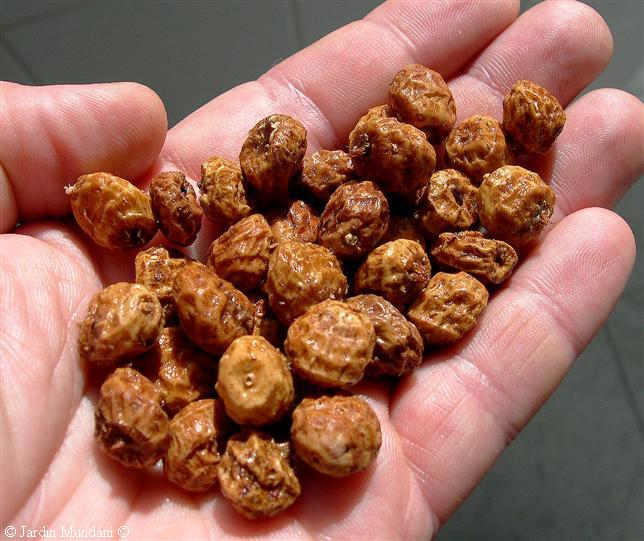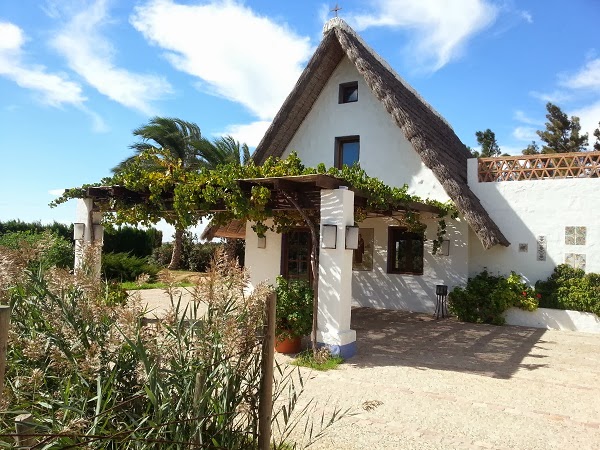
On Monday, my family and I enjoyed a wonderful "merienda" in Alboraya, world capital of Horchata and it was just brilliant. If you ever happen to be passing through Valencia I highly recommend Horchateria Panach on the main road that runs through Alboraya, as good as it gets at an unbeatable price. If you ask around Valencia many will recommend the legendary "Horchateria Daniels" and a couple of years ago I would have been one of them but recently the quality has slipped and the prices have rocketed so watch out.
 For those who are not so familiar with this summer refreshment I thought I would share some of its history and how it is grown in and around Alboraya, next to Valencia. It is made from chufa, which in English would be the tiger nut and as a drink it goes back thousands of years. Old civilizations such as the Egyptians left samples of this healthy product in their tombs and sarcophagi. Also, diverse Persian and Arab authors already mentioned in their writings the digestive benefits of the chufa. But it was in the 13th century when the Arabs introduced their crop in the Mediterranean area.
For those who are not so familiar with this summer refreshment I thought I would share some of its history and how it is grown in and around Alboraya, next to Valencia. It is made from chufa, which in English would be the tiger nut and as a drink it goes back thousands of years. Old civilizations such as the Egyptians left samples of this healthy product in their tombs and sarcophagi. Also, diverse Persian and Arab authors already mentioned in their writings the digestive benefits of the chufa. But it was in the 13th century when the Arabs introduced their crop in the Mediterranean area.
Valencia was and continues to be the only area in Europe where chufa is grown. Currently it is farmed in 16 towns around the area known as L'Horta Nord (or the Northern fertile land), which surrounds Valencia.
The chufa is cultivated in sixteen Valencian towns in the L'Horta Nord area, where a few specific climatic requirements combine and make it the only area of Spain where such a unique tuber is cultivated. About 5.3 million kilograms of tiger nut are produced in this area, of which 90% are covered by the Denomination of Origin.
The tiger nut from Valencia (Cyperus esculentus) is a herbaceous plant of around 40 to 50 centimetres in height. It has a rhizome radicular system from which some little roots grow and in the tips of these roots the tiger nut is formed.
 The chufa is sown from March until May, date which is determined by the previous crop. Before the planting begins, a series of preparatory work is carried out, so that the soil remains spongy, loose and well levelled. The planting is carried out in a mechanical fashion, in ridges 20 cm high with 60 cm between them. The depth of the seed is from 4 to 5 cm. The depth of sowing is an important aspect, since the yield and the quality of the tuber depend greatly on these measurements.
The chufa is sown from March until May, date which is determined by the previous crop. Before the planting begins, a series of preparatory work is carried out, so that the soil remains spongy, loose and well levelled. The planting is carried out in a mechanical fashion, in ridges 20 cm high with 60 cm between them. The depth of the seed is from 4 to 5 cm. The depth of sowing is an important aspect, since the yield and the quality of the tuber depend greatly on these measurements.
The harvest is carried out from November to January. Once the plant has completely withered and dried, it is burned and the ashes and remains are cleaned up. Then, it is sown again mechanically.
From March through to May, I recommend a tour around the area of Alboraya and Tavernes Blanques to see the planting. At this time of year, the harvesting from the previous year has alreadyfinished and the tubers are drying in "cambras": special drying rooms.
A few weeks after the new planting, the tuber germinates. You shouldn't miss the opportunity to see the legendary irrigation ditches of Roman origin, improved and expanded by the Arabs throughout the area, which still remain.

You should also discover both the array of orchards and crops and the different constructions in this unique area. You will find villages, shrines, and the typical Valencian “barracas” which are traditional thatched farmers' houses.
Legend says that a young villager from the fertile area of Valencia known as L'Horta offered King Jaume I a white and sweet drink. The King, very pleased, asked; "Qué es això?" (What is this?), and the young woman answered "Es llet de xufa" (Its tigernut milk). The King, having tasted the drink replied, "Això no es llet, això és OR, XATA" (This is not milk, this is gold (=OR), pretty girl (=XATA).
Legend or reality, the drink became famous throughout the country, adopting the name of Horchata de Chufa. This drink, made from the chufa is a refreshing and essential product in the Mediterranean diet thanks to its innumerable and healthy benefits.
The chufa nuts are ground in a mill. During the grinding water is introduced, approximately three litres per kilo of chufa. The mass of crushed chufa and water is macerated and the first extract is obtained by means of a press, which is later filtered or sieved if it is made at home. The residue from the filter and the press are mixed, and two litres of water are added per every Kg of grounded nut.
Later it is pressed again, it is filtered for a second extract and that is in turn added to the first extract thus creating the final extract product.
The process of production of horchata is completed when the required amount of sugar has been dissolved, normally between 100 and 150 grams per litre of extract.
Known since antiquity as a source of vitamins and nutrients, the horchata is also considered a source of health and energy the world throughout. Along with its delicious and refreshing flavour, several medical studies have accredited its many beneficial properties for the body. Investigations have concluded that the horchata has great digestive properties thanks to its high level of amino acids and starch.
Several prestigious specialists from the University of Valencia have also determined that it is rich in minerals such as phosphorous, magnesium, potassium and iron as well as unsaturated fats and proteins. It is also recommended for all types of people, from the youngest to the oldest. The natural horchata can also be drunk by patients with a declared lack of tolerance to lactose and it is recommended for pregnant women as it includes more iron and potassium than a glass of milk.
It is an energizing and nutritious drink that thanks to its characteristics has become part of the Mediterranean diet. Its cardiovascular properties are similar to those present in olive oil and it helps in reducing cholesterol and triglycerides as it has over 77% of oleic acid. All these characteristics make the Horchata of Chufa of Valencia a very complete and nutritious drink thanks to its macro and micronutrients.
Lastly, the horchata has the capacity to nourish and refresh simultaneously. Whether you have it with or without ice, in summer or winter, this drink gives you vitality while taking care of your body. According to studies undertaken by the Regulating Council of the Chufa of Valencia as well as the Faculty of Medicine and Pharmacy of the University of Valencia:
These are the health properties of the horchata made from Valencian Chufa:
• It has no cholesterol.
• It helps to reduce the cholesterol and the triglycerides due to its composition in greasy acids similar to the olive oil.
• It provides essential amino acids (such as arginine).
• It possesses a big energy value (ideal for children and sportsmen).
• It presents excellent digestive properties for its content in soluble fibre, amino acids and starch.
• It contains iron, zinc, copper and the same quantity of magnesium as the milk of a cow or goat.
• It is diuretic for its high content in water.
• It does not contain gluten, lactose or fructose.
• Horchata without sugar can be drunk by diabetic people.
• It is ideal for people with hypertension due to its low content in sodium and absence of caffeine.
• It is advisable for the prevention of the arteriosclerosis and renal insufficiencies.

So if you haven’t tried it before you now have quite a few reasons to go out and try it!